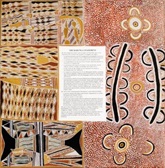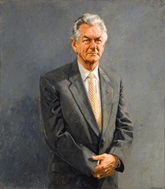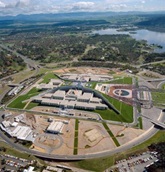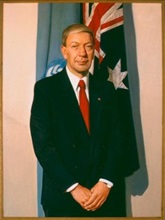|
1988
|
Building handed over
|
|
| |
Areas of the new building are progressively handed over to the Parliament from January 1988. [1]
|
|
|
1988
|
Barunga Statement
|
|
| |
The Barunga Statement is presented to the Prime Minister the Hon. Bob Hawke (ALP, Member for Wills, Vic., 1980‒92) on 12 June 1988 at the annual Barunga Festival.
The Barunga Statement comprises two bark paintings with text calling for 'Aboriginal self-management, a national system of land rights, compensation for loss of lands, respect for Aboriginal identity, an end to discrimination, and the granting of full civil, economic, social and cultural rights'. [2] The Barunga Statement is now held in the Parliament House Art Collection.
|

Galarrwuy Yunupingu AM (born 1948) Gumatj peoples, Marrirra Marawii (c.1937-2018) Madarrpa peoples, Bakulangay Marawili (1944-2002) Madarrpa peoples, Djambawa Marawili AM (born 1953) Madarrpa peoples, Dula Ngurruwuthun (1936-2001) Munyuku peoples, Djewiny Ngurruwuthun (c. 1940-2001) Munyuku peoples, Lindsay Turner Jampijinpa (1951-2009) Warlpiri peoples, Mr D Williams Japanangka (1948-2013) Warlpiri peoples, Wenten Rubuntja AM (c. 1926-2005) Arrernte peoples
Barunga Statement
1988
natural pigments on composition board with collage of printed text on paper
Presented by Central and Northern Land Councils to former Prime Minister, The Hon Bob Hawke AC, 1988
Gifts Collection, Parliament House Art Collection
Photography by Auspic
|
|
1988
|
Foundation stones relocated
|
|
| |
On Canberra Day held on 12 March 1988, a ceremony is conducted to commemorate the relocation of the Commencement Column Monument (also known as the Commemoration Stone) on Capital Hill.
The monument was originally designed to have a 20 metre column to signify the Commonwealth. It was to be erected on a hexagonal base comprising six granite blocks, one from each of the original States of the Commonwealth, on the land axis between Capital Hill and Camp Hill. Whilst the column was never completed, the hexagonal base was constructed and, on 12 March 1913, three foundation stones were laid, by the then Governor-General Lord Denman, the Prime Minister Andrew Fisher, and the Minister of Home Affairs the Hon. King O'Malley, to commemorate the founding and naming of Canberra as the national capital.
In 1981 the 63 stones making up the monument were removed from Capital Hill and stored prior to the commencement of excavation work for the new Parliament House. Following a Joint Standing Committee recommendation in 1987, the Commencement Column monument is relocated 'on the land axis immediately north of the parade ground associated with the new Parliament House'. [3] During the relocation ceremony, three new plaques are added to the monument as follows:
Beneath Sir Thomas Denman's inscription:
This plaque was unveiled by His Excellency the Right Honourable Sir Ninian Stephens, AK, GCNG, GCVO, KBE, Governor General of the Commonwealth of Australia on 12 March 1988 to commemorate the relocation of this monument.
Beneath Andrew Fisher inscription:
This plaque was unveiled by the Honourable RJL Hawke, AC, MP, Prime Minister on 12 March 1988 to commemorate the relocation of this monument.
Beneath King O'Malley's inscription:
This plaque was unveiled by the Honourable Gary Punch, MP, Minister for the Arts and Territories on 12th March 1988 to commemorate the relocation of this monument. [4]
On 12 March 2013, a formal ceremony is held to mark 100 years since the original ceremony in which Canberra was named by Lady Denman.
|
|
|
1988
|
Legislative framework for APH
|
|
| |
The Parliamentary Precincts Act 1988 (assented to on 5 April 1988) provides the legislative framework for the control and management, including management and repair, of Parliament House subject to any order of either House.
The Act, as amended, formalises the authority of the Presiding Officers to manage and control the parliamentary precincts, and describes the role of the Australian Federal Police (AFP), the Australian Parliamentary Service (APS), and the Director of Public Prosecutions within the parliamentary precincts.The Australian Constitution provides for the separation of powers between the parliament and the executive. Police, as agents of the executive, have no special rights or privileges within the precincts. As House of Representatives Practice states:
For most practical purposes, Parliament House is regarded as the only place of its kind, and one in which the two Houses through their presiding officers have exclusive jurisdiction. Thus in parliament, the police are subject to the authority of the Speaker and President and their powers are limited by the powers and privileges of the respective Houses. [5]
|
|
|
1988
|
Opening of permanent Parliament House
|
|
| |
During Australia's bicentenary celebrations Queen Elizabeth II, Queen of Australia and Head of the Commonwealth, opens the New Parliament House on 9 May 1988.
The building is Australia's first permanent Parliament House since Federation and the proclamation of the Commonwealth of Australia in 1901.[6] It is located on Capital Hill, above the provisional Parliament House opened by the Queen's father and mother in 1927. [7] In her opening speech, Queen Elizabeth II describes the significance of the permanent Parliament House:
This is a special occasion for the Parliament, but it is also a very important day for all the people of Australia. After eighty-seven years of Federation, a permanent home has been provided for Parliament, which is both the living expression of that Federation and the embodiment of the democratic principles of freedom, equality and justice….This new Parliament House will become the work place for the men and women into whose hands Australians choose to place legislative and executive responsibility. The chambers will become the centres for debate on all the pressing issues of government, and future generations of Australians will look to those who work here for national security, wise legislation and fair administration. [8]
|
Watch: Speech by Queen Elizabeth II on 9 May 1988
Video courtesy of DPS Broadcasting, Parliament House

Opening of Parliament House by Her Majesty Queen Elizabeth II on 9 May 1988 (1994), by Marcus Beilby (1951)
Image courtesy of Historic Memorials Collection, Parliament House Art Collection, Canberra ACT
|
|
1988
|
Prime Minister's speech at opening
|
|
| |
Prime Minister the Hon. Bob Hawke (ALP, Member for Wills, Vic., 1980‒92) gives an official speech to mark the opening of the New Parliament House:
…this building will become for our nation both the forum for our differences and the instrument of our unity-a building for all Australians, a Parliament reflecting the diversity of our entire society and responding to the needs of the whole community. [9]
|
Watch: Prime Minister the Hon. Bob Hawke speaking at the opening of the New Parliament House, Canberra
Video courtesy of DPS Broadcasting, Parliament House

The Hon. Robert (Bob) JL Hawke AC, 1992 by Bill Leak (1956‒)
Image courtesy of Historic Memorials Collection, Parliament House Art Collection, Canberra ACT
|
|
1988
|
Indigenous protest at opening of building
|
|
| |
During the opening ceremony of the New Parliament House on 9 May 1988, Indigenous people and their supporters mount a noisy protest in view of the Forecourt.
Former Liberal Minister and later leader of the Australian Democrats in the Senate, Don Chipp (LP, AD, Member for Higinbotham, Vic., 1960-9, Hotham, Vic., 1969-77; Senator for Victoria, 1978-86) observes:
I began to realise that a rather wonderful thing was taking place. In how many other countries on this planet would such a hostile open exhibition of dissent be allowed to proceed in full view of the reigning monarch? In a rather strange way, this outside phenomenon seemed to give real meaning to the many references being made to democracy in the speeches being delivered inside. [10]
|
|
|
1988
|
Architect's vision
|
|
| |
In the program for the opening of Parliament House, architect Romaldo Giurgola describes how the building is intended to be read:
The site of the new Parliament House is at a vital point of confluence which completes the geometry of the plan of Canberra. As conceived by Walter Burley Griffin in 1912, the plan is one of intense order which at the same time preserves a pliable and enfolding landscape. [11]
He later reflects on the importance of the design in expressing the relationship between the building and the people:
We felt if Australia's new Parliament House was to speak honestly about its purpose, it could not be built on top of the hill as this would symbolise government imposed upon the people. The building should nest with the hill, symbolically rise out of the Australian landscape, as true democracy rises from the state of things. [12]
|

Aerial of New Parliament House on opening day, 1988
Image courtesy of National Archives of Australia
|
|
1988
|
International recognition
|
|
| |
The building is recognised as a major international achievement in the integration of art and architecture, and features numerous commissioned artworks built into the fabric of the building.
Romaldo Giurgola is awarded the Royal Australian Institute of Architects Gold Medal, and Parliament House subsequently wins numerous awards for excellence including the Royal Australian Institute of Architects (RAIA) National Sir Zelman Cowan Award 1989; Canberra Medallion, RAIA, (ACT Chapter) 1989; Civic Design Award (Art/Craft/Program), RAIA, (ACT Chapter) 1991; Canberra Medallion (Water Feature in Parliament House Forecourt), RAIA, ACT Chapter, 1991; Highly Commended, Building and Civil Design, Engineering Excellence Award, (Flagmast Structure) 1989; Special Mention for Outstanding Structures, Federation Internationale de la Précontrainte, Hamburg, 1990; BHP Australian Steel Construction Award, (Flagmast Structure), 1989; Tucker Award of Design Excellence (Landscape); Building Stone Institute, New York, 1990; Honour Award, American Society of Landscape Architects, 1992. The building is also nominated by the RAIA to the International Union of Architects' World Register of Significant Twentieth Century Australian Architecture. [13] In 1989 Mr Giurgola is interviewed about his views on architecture and his experiences in designing Parliament House.
|

Aldo Giurgola 2005 by Mandy Martin, ochre, pigment and oil on linen
Image courtesy of National Portrait Gallery, Canberra
Listen: Extract of interview with Romaldo Giurgola. Interview conducted by Professor Manning Clark and Heather Rusden between 18 March and 14 October 1989 (MP3 24MB)
Duration 26:26
Audio courtesy of National Library of Australia
|
|
1988
|
Last sitting of Senate in provisional Parliament House
|
|
| |
The Senate sits for the last time in the provisional Parliament House on 2 June 1988. The President of the Senate, Senator the Hon. Kerry Sibraa (ALP, Senator for NSW, 1975‒77 and 1978‒94), states:
I am sure I speak for all senators and parliamentary staff when I say that I am experiencing mixed feelings on this historic occasion. On the one hand I am sure that we are all looking forward to the increased facilities and space in the new Parliament House, while on the other it is always with a sense of regret that one leaves familiar surroundings behind. I do not intend to dwell on the past tonight but I am certain everybody who has worked in this building in whatever capacity over the past 61 years will have memories of his or her time here: of the great characters who have served in this chamber; of the memorable political events which have occurred here since 1927; of the celebrations and wakes which have been held in various parts of the building; and of the people who have served the Parliament in so many ways over the years. [14]
The Leader of the Opposition in the Senate, Senator the Hon. Fred Chaney (LP, Senator for WA, 1974‒90; Member for Pearce 1990‒93), states:
From what has happened in the Senate since 1927 it can properly be asserted that this chamber is the only parliamentary chamber in Australia that has, in a genuine sense, retained its legislative function. Whilst I do not believe that that attracts widespread admiration and support, it has been a very worthwhile development for Australia and something which has benefited Australia. Since 1927 we have had the establishment of the Senate Standing Committee on Regulations and Ordinances, which was the first time that a parliament of this type had tackled what in the 1920s was described as the new despotism-the great proliferation of regulations and ordinances which removed people's freedom. This chamber broke new ground for the parliamentary world in its establishment of the Regulations and Ordinances Committee. The late Senator Missen promoted internationally what had been developed here. I believe it has been a great contribution to Australia and to the parliamentary world.
The introduction of a wide-ranging committee system, promoted I think initially by the late Senator Murphy-no doubt with the opposition of the government of the day; as governments of the day always oppose the exercise of parliamentary authority and power-has been an important contribution to Australia and to its welfare. The more recent establishment of the Senate Standing Committee on the Scrutiny of Bills in 1981 is an acknowledgment that for many of us the proper scrutiny of legislation is pushed aside and into a corner. The various people who have manned that Committee have made a very significant contribution. [15]
A number of senators also speak about the significance of the provisional Parliament House.
|

The Hon. Kerry Walter Sibraa , 1991 by Bryan Westwood (1930‒2000)
Image courtesy of Historic Memorials Collection, Parliament House Art Collection, Canberra ACT
|
|
1988
|
Last sitting of House in provisional Parliament House
|
|
| |
The House of Representatives sits for the last time in the provisional Parliament House on 3 June 1988.
On behalf of the House, the Prime Minister, the Hon. Bob Hawke (ALP, Member for Wills, Vic., 1980‒92) thanks former and present Members and staff who have contributed to the work of the House since the provisional Parliament House opened on 9 May 1927.
The Federal Parliament has occupied two homes since Federation and will soon move to its third and permanent home. In this building's 61 years as the provisional Parliament House, 36 Commonwealth ministries have served the nation here in the course of 26 parliaments. Madam Speaker, 61 years is a short time for so much history. Yet there can be no doubt that, measured by the importance of the events which have taken place here and the stature of the Australians who have worked here, this chamber is the most historic room in Australia. At the opening of our new and permanent home I referred to the ghosts and spirits of our parliamentary past. There is no doubt, here in these closing moments, how closely so many of them seem to crowd in upon us. It is in this room, more than anywhere else in Australia, that the process of our nationhood has developed during the past 61 years. Australia now stands as a mature, diverse, independent nation and we have reached that stage not least because of the work that has been done within these walls. They have been years of tremendous and accelerating change. Yet it is a remarkable tribute to the continuity and the stability of the Australian democracy that this institution of Parliament remains, I believe, as strong as ever and as central as ever to the fabric of our national life. This chamber-the House of Representatives, the House from which the elected governments of this nation derive that authority, the people's House-remains at the very heart of that national life.
I give this striking illustration of the remarkable continuity of this institution and, because of it, the continuity of our nation's history. The father of this present House, the honourable member for Reid (Mr Uren), served in this place during eight years-almost half-of the second prime ministership of Sir Robert Menzies. When we reflect that the honourable member for Reid was a Minister until 1987 in the Hawke Ministry and a Minister throughout the Whitlam Ministry; when we reflect that in his own person he represents a continuum with Menzies and McEwen, Evatt and Calwell; and when we reflect that they, in turn, represent a larger and a longer continuum through to Chifley, Curtin, Lyons, Scullin and Bruce, with Hughes providing a link with the first Parliament itself, surely we gain a deep and poignant sense of the long and continuing past of which we are all privileged to be a living part. Yet, for all its fundamental continuity and stability, this institution-and this chamber in particular-has never lacked its capacity for drama, for the unexpected, for turbulence and even, dare I say it, the occasional unruliness and even the odd larrikinism. [16]
The Leader of the Opposition, the Hon. John Howard (LP, Member for Bennelong, NSW, 1974‒2007), reflects on the way in which the provisional Parliament House has 'been at the very heart of our national life and our history' for 61 years:
But more important, perhaps, even than the people of whom the Prime Minister has spoken are the changes that have passed through Australia over the last 61 years. Australia's population has increased enormously. Our attitudes have changed; our allies have changed; our interests have changed; our values, in some sense, have changed; and we are a different nation from what we were 61 years ago. We have gone through different ages. Sixty-one years ago we still lived very much in an age of colonialism. Subsequently to that, we lived in what I think some would call an age of uncertainty and exuberance. [17]
A number of members also speak about the significance of the provisional Parliament House.
|
|